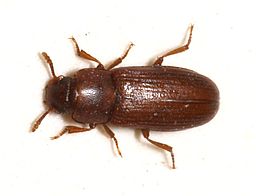SERVICE REQUEST?
Fill out the form below.
Find our nearest location
Your Local Office

Red or Confused Flour Beetle
Attribution: Sarefo, [GFDL, CC-BY-SA-3.0], via Wikimedia Commons
Size:
1/8 of an inch
Color:
Reddish brown
Behavior:
The red and confused flour beetles are nearly identical in biology and habits except that the red flour beetle flies and the confused flour beetle does not. The threat of the red flour beetle invading from an outside food source, such as grain spillage, must therefore be considered. Red and confused flour beetles are capable of breeding year-round in heated buildings. The red flour beetle is found more often in southern, warmer states and the confused flour beetle is seen in northern areas. Either species, however, could be encountered anywhere. These flour beetles are also known as “bran bugs,” being very significant pests of flour and flour by-products. Female beetles deposit eggs in twos or threes within the food material until eventually 300 to 400 eggs are laid. The larvae hatch from these eggs in about nine days and go through from 5 to 18 molts. The life cycle from egg to adult may take 7 weeks to 3 months depending on temperature and humidity conditions as well as quality of the food source. The adult beetles may live up to three years or longer.
Flour beetles are scavengers in that they cannot attack whole grains and must rely on other insects such as rice weevils or lesser grain borers to damage the kernels first. These beetles are most common in processed grain products and their flattened bodies permit them to work their way into almost any package. Flour and other processed food products heavily infested by these beetles often develop a grayish tint. This graying also promotes the growth of mold, which further contaminates the food product. Additionally, secretions from the beetles may add a disagreeable odor to the food product.
The control of any stored product pest involves many steps, primary of which is discovery of infested food items or other sources of infestation (e.g., food spillage accumulation). All dried food products need to be inspected for signs of infestation, including cereals, packaged dried foods (e.g., food bars and chocolate)and pet foods. Keep in mind that infested items may not always be stored in the kitchen. Products made of or containing vegetative materials may be stored in any room of a house. Infestations have also been traced to old rodent baits placed in attics, wall voids and similar out of the way locations. A pest management professional can be helpful in finding difficult infestation sources. Consider the following to prevent an infestation: · Discard infested foods in outdoor trash. Infested decorations (flowers, wreaths, etc.) should also be discarded. · Freeze suspect foods at zero degrees Fahrenheit for six days. · Clean cabinets and shelves where infested foods are stored by vacuuming and by using soap and water. · Store all dried food goods, including dried pet foods and birdseed, in a glass or plastic container with a tight lid. If beetles are in that food product then the infestation will be contained and not spread to other foods. · Consider storing cereals and similar foods in the refrigerator to limit stored product pest problems. · Consume older food products prior to newer purchases of the same food. Products purchased in larger quantities (e.g., from a wholesale food warehouse) are more likely to become an infestation source if these are stored for long periods of time – especially if they are not stored in containers with tight-fitting lids.
Family Name:
Tribolium castaneum, Tribolium confusum
Read What Our Clients
Are Saying
My Terminix tech Scott is the best! He is professional, courteous and absolutely thorough about his job. Thank you for sending such a blessed tech to my house. Hamlet, NC
This letter is to say how pleased we are here at Morreene West Apartments with your services. We are very pleased with the technician, Christopher. He does a great job. Durham, NC
Terminix has consistently offered our apartment complex reliable, competent service. We are completely satisfied with their knowledgeable representative who is always punctual and does a superior job for us every time. Chapel Hill, NC
I would like to take the time to thank you for giving us such great service here at Carver Pond Apartments. Your Pest Technician Christopher Mitchell has provided us with excellent service over the last few months. Christopher is such a great help to us in providing helpful information so that we can better serve our residents here at Carver Pond. Durham, NC
SERVICE REQUEST?
Fill out the form below.